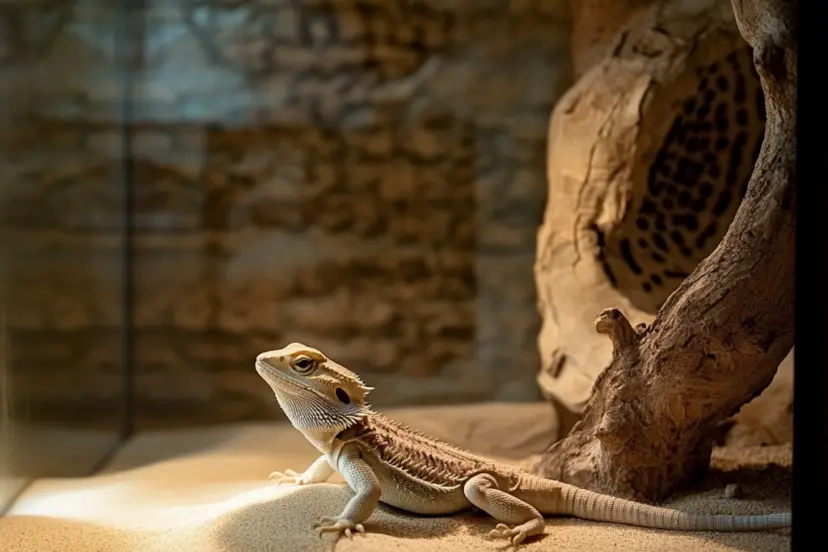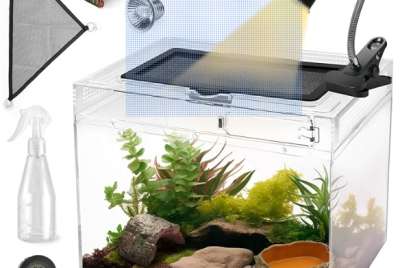Bearded Dragon Translucent Morph: Complete Care Guide
Translucent bearded dragons are one of the most stunning and unique morphs you can find. These dragons stand out due to their translucent skin and bright, almost glassy eyes, giving them a mystical appearance. As an owner or potential owner of a translucent bearded dragon, you’ll want to ensure they receive the best care possible. In this comprehensive guide, I’ll walk you through everything you need to know to properly care for your translucent bearded dragon, from understanding their genetics to setting up the right habitat.
What Is a Translucent Bearded Dragon?
A translucent bearded dragon is a special morph characterized by its lack of pigmentation in the skin, which gives it a “see-through” appearance. This trait, combined with their often striking, bright blue or purple eyes (especially in younger dragons), makes them highly desirable in the reptile community. While they share many care requirements with other bearded dragons, they do have unique needs that you should be aware of.
The Unique Genetics Behind Translucent Bearded Dragons
The translucent morph comes from a recessive genetic trait, meaning that both parents must carry the translucent gene to produce translucent offspring. Let’s dive a bit deeper into how this trait works.
Understanding the Translucent Trait
The translucent trait impacts the development of the dragon’s skin and eye color. It creates that slightly see-through effect, particularly noticeable in younger dragons before their adult colors fully develop. The translucent trait often pairs with lighter or pastel colorations, making these dragons stand out in any collection.
Why Selective Breeding is Important
Selective breeding ensures the health and vitality of translucent bearded dragons. Reputable breeders carefully pair dragons to avoid genetic issues and produce healthy offspring with strong, vibrant colors. It’s important to source your dragon from responsible breeders who prioritize the well-being of their animals over aesthetics.
Appearance and Characteristics of Translucent Bearded Dragons
One of the most appealing aspects of translucent bearded dragons is their striking appearance. From their skin to their eyes, let’s explore what makes these dragons so visually unique.
Translucent Skin and Eye Color
The hallmark feature of translucent bearded dragons is their partially see-through skin. In young dragons, this is most noticeable on the belly and limbs, where you can sometimes see internal organs faintly through the skin. Additionally, many translucent dragons are born with bright blue or purple eyes, though this color tends to fade as they mature.
Size and Physical Development
Like other bearded dragons, translucent morphs typically grow to about 18-24 inches in length when fully matured. However, some owners report that translucent dragons may have slightly slower growth rates during their juvenile stages. Keeping an eye on their diet and habitat conditions is key to ensuring they develop properly.
Setting Up the Ideal Habitat for a Translucent Bearded Dragon
Translucent bearded dragons, like all beardies, need an environment that mimics their natural habitat. Let’s take a look at how to set up the perfect home for your translucent dragon.
Tank Size and Environment
Your translucent bearded dragon will need a spacious enclosure to explore and bask in. For young dragons, a 20-gallon tank is sufficient, but adults should be housed in at least a 40-50 gallon tank. The enclosure should include plenty of basking spots, hides, and climbing branches to encourage natural behaviors.
Temperature and Lighting
Temperature and UVB lighting are crucial for all bearded dragons, and translucent morphs are no different. The basking area should be maintained at 100-110°F, with a cooler area of around 75-85°F. UVB light is essential for calcium absorption and overall health. Keep in mind that translucent dragons, due to their lighter skin and eyes, may be more sensitive to intense light. Ensure your UVB light isn’t too close to their basking spot.
Choosing the Right Substrate
A safe, solid substrate like reptile carpet, paper towels, or slate tiles is best for your translucent bearded dragon. Loose substrates like sand should be avoided as they can lead to impaction if ingested.
Feeding Your Translucent Bearded Dragon
Diet plays a huge role in your dragon’s health and growth. A balanced diet of insects and vegetables is key to keeping them strong and vibrant.
Insect Diet for Juveniles
Juvenile translucent bearded dragons should be fed a protein-heavy diet. Feed them gut-loaded insects like crickets, dubia roaches, or mealworms multiple times a day. Make sure the insects are appropriately sized to prevent choking and digestion issues.
Vegetables and Supplements for Adults
As your dragon matures, their diet should shift to include more vegetables. Adult translucent bearded dragons should eat primarily leafy greens like collard greens, mustard greens, and dandelion greens, with insects given only as occasional treats. Dust their food with calcium powder a few times a week to prevent metabolic bone disease.
Feeding Schedule and Portion Sizes
Juvenile dragons should be fed 2-3 times per day, while adults can be fed once daily or every other day. Ensure that they have access to fresh, clean water and offer vegetables daily, even if they don’t always eat them right away.
Health Considerations for Translucent Bearded Dragons
Due to their unique traits, translucent bearded dragons may face a few health considerations that other morphs do not. Awareness and prevention are key to keeping your dragon healthy.
Vision and Sensitivity to Light
Translucent dragons are more sensitive to light than other morphs due to their lighter pigmentation. Ensure they have shaded areas in their tank where they can retreat if the lighting becomes too intense.
Common Health Issues and Prevention
Translucent bearded dragons are generally hardy, but they can be prone to certain health issues like metabolic bone disease and impaction. Regular vet check-ups and a well-maintained habitat can prevent these issues from developing.
Monitoring Growth and Development
Keep a close eye on your dragon’s growth, particularly during their juvenile stage. If you notice any stunted growth or behavioral changes, consult a veterinarian to rule out potential health concerns.
Handling and Socializing Your Translucent Bearded Dragon
Translucent bearded dragons are just as social as their regular counterparts, but they may require some extra care when handling due to their delicate skin.
Best Practices for Gentle Handling
When handling your translucent dragon, be sure to support their body fully. They are usually calm and enjoy interacting with their owners, but their skin can be more fragile, especially during shedding. Handle them gently and avoid too much rough contact.
Building Trust and Comfort
Like all bearded dragons, translucent dragons need time to build trust with their owners. Spend time near their tank, offer treats by hand, and handle them gently and regularly to build a strong bond.
Shedding in Translucent Bearded Dragons
Shedding is a natural process for all bearded dragons, but translucent dragons may shed more frequently during their growth phases.
How Often Translucent Dragons Shed
Juvenile dragons typically shed every few weeks as they grow, while adult dragons shed less frequently. Translucent dragons may have a more noticeable shedding process due to their lighter skin.
Helping Your Dragon During Shedding
To help your translucent bearded dragon through the shedding process, providing warm baths can soften the old skin, making it easier for them to shed naturally. You can mist their enclosure lightly to maintain a bit of humidity, which can also ease shedding. Be patient and avoid pulling off any shedding skin manually—let it come off naturally to prevent injury to their delicate skin.
Breeding Translucent Bearded Dragons: What You Should Know
Breeding translucent bearded dragons requires knowledge and attention to genetic traits. Responsible breeding is essential to maintaining the health of the dragons and ensuring that the genetic lines remain strong.
Ethical Considerations and Best Practices
When breeding translucent dragons, it’s important to avoid overbreeding and to prioritize the health of both the parents and the offspring. Always choose dragons with strong genetic lines to reduce the risk of health issues. Many breeders take extra care to ensure that dragons with desirable traits, like translucency, are bred ethically and responsibly.
Breeding for Color and Health
Breeding translucent bearded dragons with other morphs can produce stunning color combinations. However, you should avoid breeding dragons solely for their appearance. Focus on maintaining good health and temperament as primary considerations in your breeding practices.
Conclusion: Caring for Your Translucent Bearded Dragon
Owning a translucent bearded dragon is an exciting and rewarding experience. Their unique appearance, from translucent skin to striking eye colors, makes them a standout among other morphs. However, with their special traits come specific care needs. From proper habitat setup to feeding, health considerations, and socialization, it’s important to give your translucent dragon the attention and care they need to thrive. By following the guidance in this care guide, you’ll ensure your translucent bearded dragon stays healthy, happy, and vibrant for years to come.
FAQs
- Do translucent bearded dragons require special care compared to other morphs?
While their basic care is similar, translucent dragons may need extra attention due to their sensitivity to light and more fragile skin, especially during shedding. - How can I help my translucent dragon during shedding?
Providing warm baths and lightly misting the enclosure can help soften the skin and make shedding easier. Avoid manually pulling off shedding skin. - Are translucent bearded dragons more prone to health issues?
They can be more sensitive to light and may face some unique health challenges, but with proper care, they can be just as healthy as any other morph. - What do I feed my translucent bearded dragon?
Juveniles require a protein-rich diet of insects, while adults should have a balanced diet of leafy greens with occasional insects. Supplements like calcium are important. - Can I breed a translucent bearded dragon with other morphs?
Yes, you can breed them with other morphs, but responsible breeding practices are essential to avoid health issues and ensure the dragon’s well-being.
By understanding the unique needs of translucent bearded dragons, you’ll be able to provide the best care possible, ensuring a long and healthy life for your pet!




